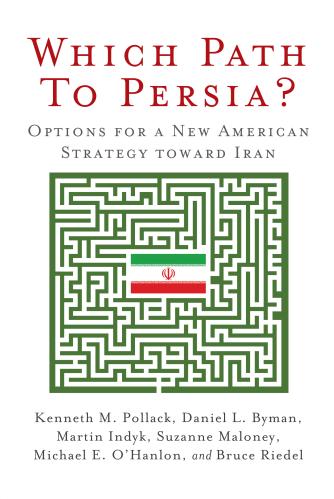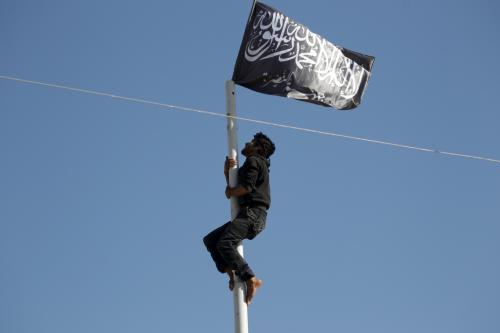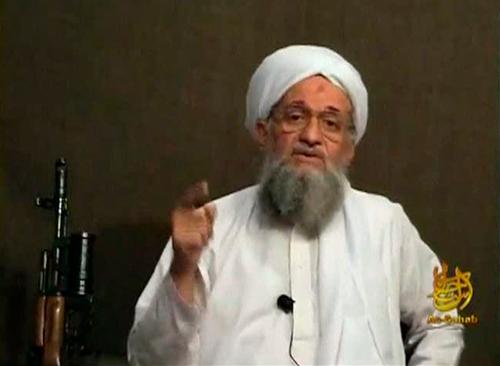Unheralded amid the recent political chaos in Washington and upheavals in the Middle East was a potential bit of good news, writes Daniel Byman: revelations that the al-Qaida core’s split from its Syrian affiliate did not resemble a gentle parting but rather an acrimonious divorce. The revelations suggest that al-Qaida wields less influence than previously feared and that U.S. efforts to isolate al-Qaida in Syria are bearing some fruit. This piece originally appeared on Lawfare.
Unheralded amid the recent political chaos in Washington and upheavals in the Middle East was a potential bit of good news: revelations that the al-Qaida core’s split from its Syrian affiliate did not resemble a gentle parting but rather an acrimonious divorce. The revelation, which emerged from a statement by a senior Syrian jihadist, a public chastisement from Ayman Zawahiri, and then and a back-and-forth involving various jihadists in Syria, suggests that al-Qaida wields less influence than previously feared and that U.S. efforts to isolate al-Qaida in Syria are bearing some fruit.
In July 2016, Jabhat al-Nusra, al-Qaida’s Syrian affiliate, formally separated from al-Qaida and took on a new name—Jabhat Fatah al-Sham (The Front for the Conquest of the Levant)—to signify the change. In early 2017, it joined with several other groups to form Hay’at Tahrir al-Sham (HTS, or Organization for the Liberation of the Levant). HTS absorbed many smaller factions and emerged as the strongest insurgent force in northwestern Syria.
When al-Qaida’s Syrian affiliate split off, both sides tried to limit the public awareness of the division, and many analysts painted it as a public relations move. The U.S. State Department still contends that HTS “remains al-Qaida’s affiliate in Syria” despite the name change, and analysts point out that many senior al-Qaida veterans remain part of the group. Believers in the PR show argue that al-Qaida aimed to increase the credibility of its most important local affiliate: Many Syrian actors hesitated to embrace a group with an open al-Qaida link, so segmenting its affiliate from the al-Qaida core seems a smart move. But PR aside, the assumption was that the group would continue to do al-Qaida leader Ayman al-Zawahiri’s bidding behind the scenes, and al-Qaida would gain a base in Syria if HTS was successful in the long-term. The split then represented a win-win for al-Qaida: It would remain in control, but its local franchise would get even stronger.
As is so often the case, observers seemed to paint al-Qaida stronger than its reality. We now know that Zawahiri opposed the divorce, but its affiliate split anyway. One reason for the split was that HTS sought to work with local groups that sought the support of the United States and its allies, which oppose any group with an al-Qaida taint. But, another reason was that the core appeared to offer its affiliate little. Zawahiri could fulminate in private but had little ability to stop the split.
A hostile split has at least five important implications. First, it suggests that al-Qaida’s influence continues to wane. The core group has failed to conduct a serious terrorist attack in more than a decade. Drones and arrests have taken their toll, devastating the core leadership and forcing the remainder into hiding. In recent years, the Islamic State has gained more attention, attracting recruits and funders that previously would have supported al-Qaida. The Syrian defection from al-Qaida is a powerful indicator of the group’s decline.
Second, the split suggests al-Qaida brand fails to entice potential supporters. Zawahiri, as expected, has proven an uninspiring leader. His rhetoric is tired, and he seems unable to capture the hearts and minds of young radicals in the Middle East. The promotion of Hamza Bin Laden in al-Qaida’s propaganda attempts to restore some of the old al-Qaida magic, but he lacks his father’s military record and spent most of his adult years in hiding. Al-Qaida’s anti-U.S. focus retains some popularity but also seems somewhat outdated and irrelevant given the wave of sectarianism sweeping the Middle East and the excitement generated by the Islamic State’s declaration of a caliphate—both of which al-Qaida opposed. Indeed, Zawahiri reportedly considered changing al-Qaida’s name to rebrand the group, attempting to remove the taint.
Third, the messy divorce suggests that a stronger HTS will not necessarily result in a long-term win for al-Qaida. Many feared that if HTS gained power in Syria, eventually the group would use Syria as a base for attacks against the United States and the West—a repeat of Afghanistan under the Taliban. But the schism indicates that HTS will not be an al-Qaida division in the heart of the Arab world.
HTS’ success in Syria is still bad for the United States, because the group’s goals and ideology are noxious. But even on this front, there is good news, as HTS looks vulnerable too. Indeed, HTS appears to have arrested several al-Qaida loyalists within the group and claims it will try them for spreading dissension. As this suggests, HTS is far from unified. To the contrary, HTS abounds with internal divisions, and some leaders have split from the group, taking their fighters with them.
Fourth, the acrimonious split raises questions about al-Qaida’s ability to regain leadership over the global jihadist movement as the Islamic State’s caliphate collapses. If al-Qaida cannot maintain the loyalty of its own affiliates, it will be hard to win over groups without prior affiliation.
Finally, the split represents a rare win for U.S. policy in Syria, which can claim some credit for pushing al-Qaida and its affiliate apart. Without U.S. and allied pressure on local groups to shun al-Qaida, the group’s Syrian affiliate would have less incentive to leave the core group. Such pressure cannot fully explain the split, and at best it produces quiet wins—but the United States must continue pressuring regional groups. Indeed, HTS still struggles to gain allies because of its al-Qaida association. As Thomas Joscelyn contends, “some of the parties who decided against joining HTS cited the possibility that they would be designated by the US as terrorists if they did so.” The United States should continue to make clear that ties to any group with an anti-U.S. focus will be costly.
The resulting threat to the United States from HTS and al-Qaida needs to be reevaluated. If HTS is indeed more local, then it poses a danger to U.S. interests in the Syrian conflict and in nearby states—a security concern, but only one of many. Given the Trump administration’s willingness to let the Assad regime and its Hezbollah and Iranian friends win in Syria, the administration will likely paint HTS as a regional problem, not America’s. Indeed, affiliates should be seen primarily (though not entirely) in the context of U.S. interests in the Middle East.
The Brookings Institution is committed to quality, independence, and impact.
We are supported by a diverse array of funders. In line with our values and policies, each Brookings publication represents the sole views of its author(s).











Commentary
An al-Qaida setback in Syria?
December 8, 2017